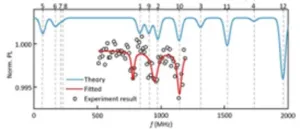(Press-News.org) By analyzing data from the Harvard Implicit Association Test—a widely accepted measure of a person’s attitudes toward people based on characteristics like race, gender, and sexuality—researchers find that healthcare professionals, and in particular nurses, are more biased against transgender people than are people who are not healthcare professionals. A questionnaire administered before and after the test shows that healthcare professionals are less likely to know transgender people personally and that nurses are more likely to conflate sex and gender identity. These results are reported November 3 in the journal Heliyon.
The Implicit Association Test works by asking participants to categorize groups of people with “good” words like “nice” or “laughter” and “bad” words like “nasty” or “rotten.” Its results are collected by a team of scientists as a part of Project Implicit since 1998 and are made available for use by the public and other researchers.
To specifically assess the attitudes of healthcare professionals towards transgender people, the researchers focused on a subset of the respondents from 2020 to 2022, including 11,996 nursing healthcare professionals and 22,443 non-nursing healthcare professionals. These responses were compared to 177,810 responses of non-healthcare professionals.
A person’s bias is reported as their “D-score,” which can range from -2 to 2, with higher scores indicating more anti-transgender views. The standard classification for this test lists values over 0.15 as “slightly biased,” and over 0.35 and 0.65 as “moderately” and “strongly” biased, respectively.
Non-healthcare professionals on average reported a D-score of 0.116, which is considered to mean that they have little to no bias. However, healthcare professionals (non-nursing), reported an elevated score of 0.149, which is on the edge of what is considered to be “slightly biased.” The average D-score for nursing healthcare professionals was 0.176, which falls clearly within the range of “slightly biased.”
The participants’ D-score assesses their implicit bias—their true beliefs which they may be too reluctant to share—but their explicit bias, or their self-reported views, were assessed by a questionnaire.
Nursing healthcare professionals were significantly more likely to agree with statements like “I believe a person can never change their gender” or “I think there is something wrong with a person who says they are neither a man nor a woman” compared to other healthcare professionals and non-healthcare professionals.
“Our finding that nurses have higher levels of implicit bias towards transgender people may be related to a tendency to conflate sex and gender identity, as shown by higher levels of agreement with transphobic statements that conflate these two distinct concepts,” write authors Daniel W. Derbyshire (@DWDerbyshire) of the University of Exeter and Tamsin Keay of Coventry University.
The questionnaire also asked about the participants’ relationships with transgender people in their daily lives. While healthcare professionals—including nurses and non-nurses—were more likely to have met a transgender person than non-healthcare professionals, they reported that they were less likely to have a transgender friend or family member.
“This suggests that healthcare professionals’ (both nurses and non-nurses) experience of interacting with transgender people may be largely confined to a work context,” write the authors.
The authors note that the participants in this test are limited to those who visited the Project Implicit website and chose to complete the test. “As such, the sample may be subject to sample selection bias in terms of the demographics and Implicit Association Test (IAT) results of participants,” write the authors. “However, it may be anticipated that people with particularly negative attitudes towards transgender people would avoid taking the Transgender IAT and the results presented here may therefore under-represent the extent of implicit bias towards transgender people.”
###
Heliyon, Derbyshire et al. “Nurses’ Implicit and Explicit Attitudes towards Transgender People and the need for Trans-Affirming Care” https://cell.com/heliyon/fulltext/S2405-8440(23)07970-7
Heliyon (@HeliyonJournal), part of the Cell Press family, is an open access journal publishing scientifically accurate and valuable research across life, physical, social, and medical sciences journal. Visit https://www.cell.com/heliyon. To receive Cell Press media alerts, contact press@cell.com.
END
About The Study: The findings of this study of 414,000 respondents to the 2021 Behavioral Risk Factor Surveillance System survey suggest that e-cigarette use remained common during the COVID-19 pandemic, particularly among young adults ages 18 to 24 (18% prevalence). Notably, 71.5% of individuals ages 18 to 20 who reported current e-cigarette use had never used combustible cigarettes. These results underscore the rationale for the implementation and enforcement of public health policies tailored to young adults.
Authors: Michael J. Blaha, M.D., M.P.H., of the Johns Hopkins ...
A survey from Ann & Robert H. Lurie Children’s Hospital of Chicago found that 40 percent of parents who worked remotely during the pandemic reported higher parenting stress compared with only 27 percent of parents who worked onsite.
Results revealed a gender difference – fathers who worked from home were twice as likely to report that parenting was stressful all or most of the time compared to fathers who worked onsite. Parenting stress for mothers who worked at home was slightly higher, but it did not reach statistical significance.
The study found no differences ...
About The Study: In this study of a nationally representative sample of 7,062 non-Hispanic Black or white adults, health care spending for Black adults in the U.S. was equal to or less than that of white adults, but only in areas of racial and economic equity and equitable insurance access. The results underscore the continuing need to recognize place as a contributor to race-based differences in health care spending.
Authors: Lorraine T. Dean, Sc.D., of the Johns Hopkins Bloomberg School of Public Health in Baltimore, is the corresponding author.
To access the embargoed study: Visit our For The Media website at this link https://media.jamanetwork.com/
(doi:10.1001/jamahealthforum.2023.3798)
Editor’s ...
Findings revealed a gender difference
‘Might be a reflection of societal expectations that men should prioritize work obligations over family needs’
Study authors offer tips for parents, employers to mitigate stress of remote work
CHICAGO --- Forty percent of parents who worked remotely during the COVID-19 pandemic reported higher parenting stress compared with only 27 percent of parents who worked onsite, reports a new survey from scientists at Northwestern University and Ann & Robert H. Lurie Children’s Hospital ...
Researchers at the IBB-UAB have developed the most comprehensive database available to date to help understand the basis of protein aggregation, a phenomenon associated with ageing and several pathologies. The new resource, A3D-MOBD, brings together the proteomes of twelve of the most studied model organisms which cover distant biological clades and contains over half a million predictions of protein regions with a propensity to form aggregates.
The A3D-MOBD was developed by the Protein Folding and Computational Diseases Group at the Institut de Biotecnologia i de Biomedicina of the Universitat Autònoma de Barcelona (IBB-UAB), which is directed by Biochemistry and ...
Measuring the pH of substances gives us vital clues about the world around us, such as identifying contaminated water or checking the toxicity of medical or cosmetic products.
Often, only small amounts of samples are available, but monitoring the variation in pH in these miniscule volumes matters. For example, identifying pH changes within tiny volumes of fluid from single cells can help in the detection of ovarian cancer.
However, the current methods for measuring pH are mainly for bulk solutions and are not sensitive enough or are too fragile to measure small volumes on a commercial scale.
In a recent study published in Microchimica ...
Teams led by Prof. DU Jiangfeng, Prof. SHI Fazhan and Prof. KONG Fei from the University of Science and Technology of China (USTC) of the Chinese Academy of Sciences (CAS) used the Nitrogen-Vacancy (NV) center inside a single nanodiamond for quantum sensing to overcome the problem of random particle rotation.
The study was published on Oct. 7th in Nature Communications.
It is an important goal to detect and analyze molecules under physiological in situ conditions in the field of life sciences. Only by observing biomolecules under this condition can we reveal conformation changes when they realize physiological functions.
Thanks to its high sensitivity, good biocompatibility, and ...
A new study from Carnegie Mellon University, Bayes Business School (formerly Cass), and Bocconi University has found that men are less eager and likely to share negative information than women, while there was little difference when it comes to positive news.
Published in the Journal of Experimental Social Psychology, the authors suggest that this may be due to a greater concern among men over how other people will see them, resulting in a tendency to self-promote by sharing positive information about themselves and not revealing their negative experiences to others.
Dr Erin Carbone, Visiting Assistant Professor in the Department of Social ...
A new publication from Opto-Electronic Science; DOI 10.29026/oes.2023.230025 discusses near-eye display based on metasurface devices.
With the rise of the meta-universe, virtual reality (VR) and augmented reality (AR) technologies have been developing rapidly in recent years. Near-eye displays are crucial technologies for VR and AR. Despite the rapid advances in near-eye display technologies, there are still challenges such as large field of view (FOV), high resolution, high image quality, natural free 3D effect, and compact form factor. Great efforts have been devoted to striking a balance between visual performance and device compactness. ...
A new publication from Opto-Electronic Science; DOI 10.29026/oes.2023.230026 overviews liquid crystal spatial light modulators devices and applications.
Technology to control and harness light has existed for centuries, often as static solutions that must be custom-designed. It is only in the past couple of decades that the digital era of micro-electronics and computing has seen fast rewritable technology meant for displays find its way into the mainstream of optics. In this review, the authors showcase the recent advances in replacing the traditional static optical toolkit with a modern digital toolkit for “light on demand”. ...







